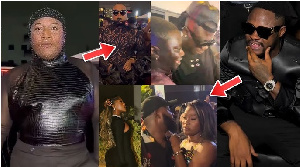Opinions of Tuesday, 22 February 2022
Columnist: Abdul Rahman Odoi
The struggle to ‘somebodiness'
A summary of hundred pages of Luther’s autobiography, impeccably edited by Clayborne Carson, hinges on a tidal wave of racial slur and the difficulty of negro existence in the Black Community of Montgomery, a capital city of the U.S. state of Alabama.
The narration took the form of his early days as a child and the parental support he had had from his religious parents. Followed by his college life which was intertwined with his ultimate love for God, and subsequently becoming a Reverend. But swiftly, the reader has put to mirror the rapacious segregation the white supremacist at the time were priding themselves therewith.
Luther Jr. was only eight years when he got slapped by a white lady who couldn’t say anything better than that the little him had stepped on her foot. A negro dares not to retaliate in such an instance because a white person was involved. Even so, in Atlanta, negro kids could not go to the common park alone. Not to say to be enrolled in a so-called white school. Swimming too was out. He couldn’t go to some of the store's downtowns to get hamburgers or coffee.
The racialism didn’t stop. He would grow later in life to the realization that the negro had been submerged into deep dirty drainage of “nothingness” by the white supremacist. They, through a series of waged protests, as a black community, came together and formed the Montgomery Improvement Association (MIA). And lo, Luther was elected to head the movement to restore the negro’s “somebodiness” in Montgomery.
The first move of (MIA) was to wrestle the strict segregation system. White supremacists had created the system to demean the black colored people. They believe that negress deserves the rear seat of public transport. The negro is worthless, black, and backward, hence, even in the bus, they ought to be at the rear. A negro mustn’t sit on the empty seats in a bus, even when white persons aren’t onboard. They should stand while the bus moves about half-fulled.
Their (MIA) agitations had taken turns and started simmering when Luther Jr. was illegally arrested for overspeeding, albeit his car was moving at a normal speed. The black community didn’t rest on that bad news. They had come to realize that ‘black lives matter. Ralph Abernathy, his confidant, was the first to arrive at the jail. And was prepared to pay some cash bond for Luther’s release, because he couldn’t afford to wait to see his friend tomorrow, as suggested by the jailer. They (negro) thronged in the City Jail of Montgomery. The result was Luther King Jr.'s release.
To discourage the (MIA), Luther’s home was boomed. But his wife, Coretta Scott, who was very instrumental with selfless sacrifices in the course of the movement, and baby, Yoki, weren’t injured. Thank God.
There were other tactics like divide, conquer and rule by the white supremacist to sow seeds of hostilities among members of (MIA). Also, various accusations were leveled against him. One of such was the rumors that he had purchased a brand new Cadillac for himself and Buick station for Correta. Regardless, their fight for “somebodiness” continued unabated.
On December 20, 1956, the bus integration order reached Montgomery. And they won the litigation from the Supreme Court. That the bus segregation must die and be buried. Even though Luther King Jr. captured those moments as ‘Our faith seems vindicated’, the white supremacist refused to relent their myopic, hollow, and lame racial haughtiness, in their quest to prove to the negro that they are a people, for sure, born into “nothingness”. They (whites) deserved to reign over them (negress), not otherwise.
For instance, a white elderly man, who came on board of a bus which serviced the white residential section, the very day the court order of integration was passed, got peeved so much that he stood up, though a suggestion was made to him that there were empty seats at the rear, he arrogantly declared: “I would rather die and go to hell than sit behind a nigger.”
There’s also an account of a white woman who took a seat by a negro and when she had noticed it was her negro neighbor, she jumped and radically said: “I wonder what these negro would do best.”
One negro woman was also slapped by a white man after she had alighted but she refused to retaliate. The victim remarked that: “I could have broken that little fellow's neck all by myself, but I left the mass meeting last night determined to do what Reverend King asked.”
The negro lady’s reference to Reverend Luther King Jr. was the pivotal principle he built the Montgomery Improvement Association (MIA) on. And that was ‘nonviolent resistance’, which originated from Mahatma Gandhi’s principles, his mentor. So, they (negro) never fought back, as in giving reprisal attacks, in whichever form they were attacked, but except that they organized a mob, use the sword of their intellects, and their tongue’s dagger to demand equal rights and bury civil disobedience.
The white supremacist, during the 1910s and beyond, reading from the book, would carefully realize that their wish was that the negro should keep quiet for them to put mud in their mouths. If they fart, the negro was supposed to enjoy its smell. Their urine had to be a sweet tonic for the negro. Their sweat, the negro should bathe himself with it.
But unluckily for them, Martin Luther King Sr. and Alberta Williams King had birthed Martin Luther King Jr, who holds a maxim that: “Our lives begin to end the day we become silent about things which matter.” So they fought the system!
Entertainment










